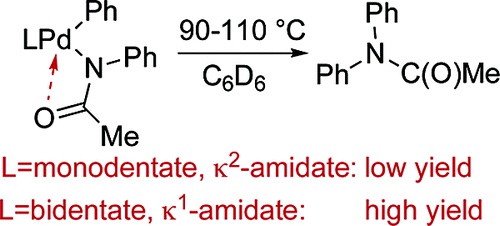Organometallic Chemistry from Amidate Complexes. Reductive elimination of N-Aryl Amidates from Palladium(II)
J. Am. Chem. Soc., 2006, 128 (9044-9045)
View on publisher site
Abstract
We report a series of arylpalladium complexes of acetamidate, sulfonamidate, and deprotonated oxazolidinone ligands that undergo reductive elimination with rates and yields that depend on the binding mode of the ancillary and amidate ligands. Complexes of the acetamidate ligands containing the bidentate phosphines DPPF and Xantphos as ancillary ligands undergo reductive elimination. The rate and yield were higher from the complex ligated by Xantphos, which contains a larger bite angle. In contrast, the analogous amidate complex containing a single sterically hindered monodentate ligand and a κ2-bound amidate ligand does not undergo reductive elimination. This trend of faster reductive elimination from complexes containing bidentate ancillary ligands than from a complex with a single monodentate ancillary ligand is unusual and is consistent with an effect of the denticity of the ancillary ligand on the binding mode of the amidate. Complexes of sulfonamidate ligands underwent reductive elimination faster than complexes of acetamidates, and reductive elimination occurred from complexes containing both bidentate and monodentate ancillary ligands. Like reductive elimination from the acetamidate complexes, reductive eliminations from the sulfonamidate complexes were faster when the complexes possessed bidentate Xantphos and κ1-sulfonamidate ligands.
Read on publisher's site